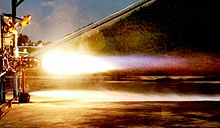Kestrel (rocket engine)
The rocket engine Kestrel (English for the American Kestrel , kestrel and various other small falcons ) is a pressure-funded LOX - / RP-1 - liquid-propellant rocket . The Kestrel engine was developed by the US company SpaceX for use in the upper stage of the Falcon 1 rocket .
Description of the engine
The Kestrel engine uses the same injection geometry as the SpaceX Merlin , but unlike this main stage engine , it has no turbo pump . The fuel is delivered solely by the tank pressure.
The combustion chamber as well as the narrowest cross section of the nozzle are ablative cooled while the actual nozzle from a high strength niobium - alloy consists and radiatively cooled. Compared to carbon fiber reinforced carbon , the metal has a higher resistance to cracking. According to SpaceX, small impacts ( space debris , step separation ) only deform the material, but this does not have a major impact on the engine behavior.
The efficiency of the pressurized gas helium used is considerably increased by using a titanium heat exchanger . This is located at the boundary between the ablative material and the niobium alloy of the nozzle.
Thrust vector control ( nod and yaw ) is implemented by electro-mechanical actuators on the upper part of the engine. Rolling (as well as position control during ballistic phases) is provided by helium cold gas engines .
To guarantee that the engine can be reignited , a TEA- TEB system is used for ignition. Due to the reignition, a higher flexibility can be achieved in the mission planning as well as in the height and inclination of the target orbit.
Kestrel 2
The Kestrel 2 is an improved version of the original Kestrel engine. The changes concern u. a. a reduction in manufacturing tolerances, a higher specific impulse (ISP) and a reduced net weight.
Data and key performance indicators
| parameter | Kestrel 2 |
|---|---|
| Manufacturer, country | SpaceX , USA |
| Type | Upper stage propulsion, pressurized liquid rocket engine |
| Fuels | LOX / RP-1 |
| Vacuum thrust | 31 kN |
| Specific impulse (vacuum) | 317 s |
| Combustion chamber pressure | 9300 hPa (9.3 bar) |
| Ratio of thrust to weight | 65 |
| Weight | 52 kg |
Swell:
Web links
- Bernd Leitenberger: The Falcon 1 and 1e
- SpaceX: Kestrel Engine ( Memento from April 5, 2013 in the Internet Archive )
Individual evidence
- ↑ Greg Zsidisin: SpaceX Confirms Stage Bump On Demo Flight 2 , Space Daily. March 23, 2007. Retrieved September 30, 2008.
- ↑ Falcon 1 Flight Three Press Kit (PDF; 1.3 MB) SpaceX. Archived from the original on October 1, 2008. Retrieved September 30, 2008.
- ↑ Chris Bergin, Braddock Gaskill: Elon Musk Q and A - Updates SpaceX status on Falcon and Dragon . NASAspaceflight.com. September 24, 2007. Archived from the original on May 29, 2008. Retrieved June 16, 2008.
- ↑ Falcon 1 Users Guide (English) (PDF), SpaceX. September 28, 2008. Archived from the original on October 1, 2008.
- ↑ spacelaunchreport.com - falcon (English)
- ↑ Kestrel in the Encyclopedia Astronautica (English)

